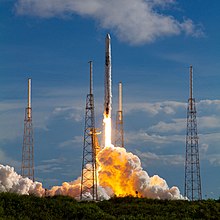SpaceX CRS-18
 Dragon C108.3 approaching the ISS | |
| Names | SpX-18 |
|---|---|
| Mission type | ISS resupply |
| Operator | SpaceX |
| COSPAR ID | 2019-044A |
| SATCAT no. | 44446 |
| Mission duration | 32 days, 22 hours, 19 minutes |
| Spacecraft properties | |
| Spacecraft | Dragon 1 C108 |
| Spacecraft type | Dragon 1 |
| Manufacturer | SpaceX |
| Dry mass | 4,200 kg (9,300 lb) |
| Dimensions | Height: 6.1 m (20 ft) Diameter: 3.7 m (12 ft) |
| Start of mission | |
| Launch date | 25 July 2019 22:01 UTC[1] |
| Rocket | Falcon 9 Full Thrust (B1056) |
| Launch site | Cape Canaveral, SLC-40 |
| Contractor | SpaceX |
| End of mission | |
| Disposal | Recovered |
| Landing date | 27 August 2019 20:20 (2019-08-27UTC20:21) UTC[2] |
| Landing site | Pacific Ocean off Baja California |
| Orbital parameters | |
| Reference system | Geocentric |
| Regime | Low Earth |
| Inclination | 51.6° |
| Berthing at ISS | |
| Berthing port | Harmony nadir |
| RMS capture | 27 July 13:11 UTC[3] |
| Berthing date | 27 July 2019 16:01 UTC[4] |
| Unberthing date | 27 August 2019 12:25 UTC[5] |
| RMS release | 27 August 2019 14:59 UTC[5] |
| Time berthed | 30 days, 20 hours, 24 minutes |
 NASA SpX-18 mission patch Commercial Resupply Services ← SpaceX CRS-17 NG-12 → | |
SpaceX CRS-18, also known as SpX-18, was SpaceX's 18th flight to the International Space Station under the Commercial Resupply Services program for NASA. It was launched on 25 July 2019 aboard a Falcon 9 rocket.[6][7]
The same Dragon capsule has previously flown to the ISS in April 2015 and December 2017.[8] This was the first time a capsule was used for a third flight.
Primary payload

In February 2016, it was announced that NASA had awarded a contract extension to SpaceX for five CRS additional missions (CRS-16 to CRS-20).[9]
NASA has contracted for the CRS-18 mission from SpaceX and therefore determines the primary payload, date/time of launch, and orbital parameters for the Dragon space capsule. It carried the third International Docking Adapter (IDA-3).[10]
The following is a breakdown of cargo bound for the ISS:[11]
- Science investigations: 1,192 kg (2,628 lb)
- Crew supplies: 233 kg (514 lb)
- Vehicle hardware: 157 kg (346 lb)
- Spacewalk equipment: 157 kg (346 lb)
- Computer resources: 17 kg (37 lb)
- External payloads: IDA-3 534 kg (1,177 lb)[12]
The Dragon spacecraft also featured a handful of ceramic heat shield tiles, meant to flight-test a critical component of the SpaceX Starship spacecraft.[13]
Gallery
-
 Launch of CRS-18
Launch of CRS-18 -
 Falcon 9 landing at LZ-1
Falcon 9 landing at LZ-1 -
 Dragon approaching the ISS
Dragon approaching the ISS -
 Dragon decals indicating two prior flights
Dragon decals indicating two prior flights
See also
References
- ^ Clark, Stephen (July 25, 2019). "New docking port, spacesuit and supplies en route to space station". Spaceflight Now. Retrieved September 23, 2019.
- ^ Bergin, Chris (August 27, 2019). "CRS-18 Dragon completes mission with Pacific Ocean Splashdown". NASA SpaceflightNow. Retrieved August 31, 2019.
- ^ Dragon Captured With New Science Experiments
- ^ Dragon Installed to Station’s Harmony Module for Cargo Operations
- ^ a b Live coverage: Dragon supply ship heading back to Earth today
- ^ "Launch Schedule". Spaceflight Now. July 19, 2019. Retrieved July 19, 2019.
- ^ SpaceX (July 25, 2019), CRS-18 Mission, retrieved July 25, 2019
- ^ @SpaceX (July 19, 2019). "The Dragon spacecraft supporting this mission previously visited the @space_station in April 2015 and December 2017" (Tweet) – via Twitter.
- ^ de Selding, Peter B. (February 24, 2016). "SpaceX wins 5 new space station cargo missions in NASA contract estimated at $700 million". Space News. Retrieved February 24, 2016.
- ^ Pietrobon, Steven (August 20, 2018). "United States Commercial ELV Launch Manifest". Retrieved August 21, 2018.
- ^ "spaceflightnow.com/2019/07/25/new-docking-port-spacesuit-and-supplies-en-route-to-space-station". July 25, 2019. Retrieved July 25, 2019.
- ^ "SpaceX's Cargo Dragon to Deliver New Space Station Docking Adapter for Commercial Crew Spacecraft". NASA. July 12, 2019.
- ^ Ralph, Eric (July 24, 2019). "SpaceX testing ceramic Starship heat shield tiles on flight-proven CRS-18 Cargo Dragon". Teslarati. Retrieved July 24, 2019.
External links
- NASA
- SpaceX official page for the Dragon spacecraft
- v
- t
- e


| Demo flights | |
|---|---|
| ISS logistics | |
| Crewed missions |
- Ongoing spaceflights in underline
- Italics indicates future missions
- Symbol † indicates failed missions

















